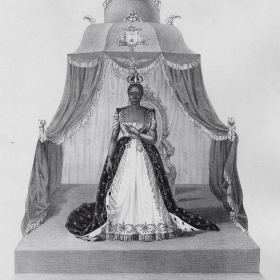At this year’s Ruhlman Conference, the first held in person since 2019, Deana-Rae Weatherly ’22 gave a presentation titled “Icon of a Nation: Black Womanhood in Jamaican Visual Culture,” based on her art history thesis. Weatherly, a Mellon Mays Fellow and the recipient of the Plogsterth Prize in Art History, is headed to the University of Texas, Austin, this fall to pursue a Ph.D. in Africana studies. Wellesley spoke with Weatherly after her Ruhlman presentation about her journey as a scholar so far. This interview has been edited for length and clarity.
What is your thesis elevator pitch?
My thesis focuses on the role of Black female iconography in the formation of Jamaica’s national identity. I analyzed two major icons for Black women in Jamaica: national hero Queen Nanny of the Maroons, the military leader who was instrumental in Afro-Indigenous resistance against imperial forces in Jamaica in the 17th and 18th centuries, and the first dancehall queen, Carlene, who served as the face of dancehall as it developed into a worldwide phenomenon. [I studied them] to understand how Jamaica transitioned from a British colony to a free society. Along the way, political leaders reinstated a brand of neocolonialism, and when Black women came to have the agency to define their own identities, they pushed back against this neocolonialism and created a more equitable society.
At Ruhlman, you said there is not much scholarship on this topic yet. Could you elaborate?
Dancehall music was something that was part of my life growing up [with family members who were born in Jamaica]. So to be able to research this, it was like going back to the cultural formation of my own childhood. Having the essence of novelty and always wanting to look different—in my outfits, but also different from everybody else—is something [from dancehall] that really, really inspired me. Doing this research, I felt really fulfilled, even though it was really difficult. Being able to write this thesis as [scholarship] that’s new and that’s exciting … If somebody else wants to write about this in the future, and my name is attached to it as being the first person [to study this], that’s crazy.






We ask that those who engage in Wellesley magazine's online community act with honesty, integrity, and respect. (Remember the honor code, alums?) We reserve the right to remove comments by impersonators or comments that are not civil and relevant to the subject at hand. By posting here, you are permitting Wellesley magazine to edit and republish your comment in all media. Please remember that all posts are public.